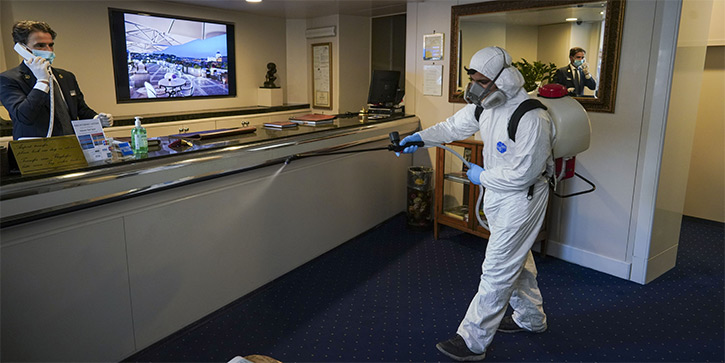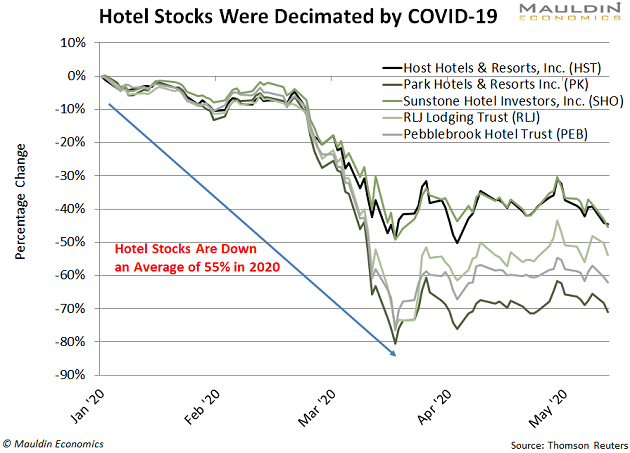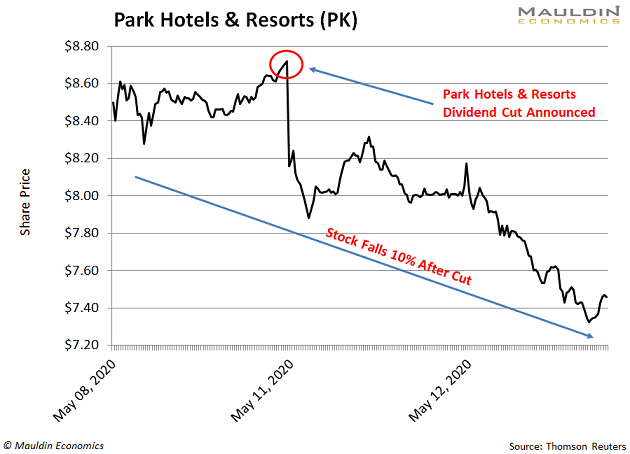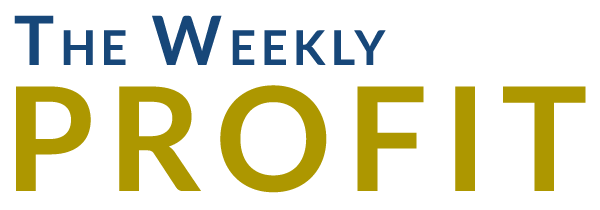
You’ll Want to Vacate This “Last Man Standing” Hotel Stock
- Robert Ross
- |
- The Weekly Profit
- |
- May 13, 2020
Most Americans have been staying home for the past two months to prevent the spread of COVID-19.
Some states like Florida and Texas are starting to reopen non-essential businesses. But two-thirds of Americans say they plan to stay close to home for at least the next one to six months.
Not only are they not planning to travel, the latest Harris Poll shows 42% of people say it will take about six months before they want to get on a plane. The outlook is even bleaker for the hospitality industry, as 52% want to see a flat infection curve for six months before they think of staying in a hotel.
From economy rooms to luxury suites, some 80% of America’s hotel rooms are standing vacant these days. With no demand for lodging, hotel stocks are down 50% this year:

Even with the S&P 500 bouncing back 35%, hotel stocks can’t catch a break.
But this makes sense. With hotel occupancy near zero, many analysts don’t expect the industry to bounce back to pre-COVID levels until 2023.
That’s especially true for a subset of hotel stocks…
I’m talking about hotel Real Estate Investment Trusts (REITs).
This Segment of the Hotel Market Is in Sorry Shape
We’ve talked about REITs before. They’re special business that own different kinds of properties—hospitals, factories, commercial real estate, and—you guessed it—hotels!
REITs are required to pay out 90% of their income as dividends. Even before the COVID-19 crisis, hotel REITs were paying huge dividend yields.
But with the stock prices of hotel REITs cratering, these dividend yields have ballooned. That’s because when stock prices fall and dividends stay the same, the dividend yield rises.
And you know what happens when dividend yields rise overnight… it’s usually a short stay.
When companies have cash left over after factoring in expenses, they often return a chunk of that cash to shareholders as cash payments, or dividends.
That’s why REITs are so attractive to income-starved investors—that 90% payout is nothing to sniff at.
But as we’ve seen with the cruise industry and casinos, both of which have empty beds for miles, their dividends have been anything but immune to this post-coronavirus world.
And it only makes sense that actual hotels, and the REITs that represent them, will follow suit…
The World’s Largest Hotel REIT Slashed Its Dividend
Most hotels have shut down their operations. That means these companies have little to no money coming in.
This leaves little room for dividend payments. For instance, let’s look at Park Hotels & Resorts (PK).
Park is one of the largest hotel REITs in the US. And the company has fallen on hard times. The company has closed more than half of its hotel portfolios, and currently has an occupancy rate of 15%.
The dividend yield for a company is found by taking the annual dividend paid divided by the share price.
- Park paid $1.90 in dividends in 2019. The stock traded for $25 on Jan. 1, 2020.
- That means it had a dividend yield of 7.6% (i.e., $1.90 in dividends / $25 share price).
- But now that Park’s price fell 68%, the dividend yield soared to 24%.
If a company can meet its dividend payment, that’s great news for dividend investors. But when a company or, in this case, an entire industry, is in trouble, a dividend cut is likely when the yield gets too high.
For Park investors, that would have been a preferable outcome. Unfortunately for them, last week the company suspended its dividend payment entirely.

This sent shares down 10% after the announcement.
But Park Hotels & Resorts won’t be the last hotel REIT dividend to bite the dust.
How to Tell if Your REIT’s Dividend Is Safe
A tried-and-true way to tell if a REIT’s dividend is safe is to look at a company’s funds from operations (FFO) payout ratio.
The FFO payout ratio is the percentage of funds from operations a company pays to shareholders as dividends. The lower the FFO payout ratio, the safer the dividend payment.
When a company’s dividend rises faster than its funds from operations, the payout ratio rises.
As a rule of thumb, an FFO payout ratio over 80% is usually not sustainable.
But in Park Hotels & Resorts’ case, the payout ratio would be 133%.
For income investors, there’s an even worse bet out there…
This “Last Man Standing” Will Soon Cut Its Dividend
In total, 15 of the 18 US hotel REITs have suspended their dividends.
Two of the remaining three have reduced their dividend to just one penny.
That leaves one hotel REIT standing: Host Hotels & Resorts (HST).
HST is the largest hotel REIT in the US. While every other hotel REIT has either suspended or cut its dividend, HST has kept the payouts coming. In fact, the company is currently sporting a dividend yield of 7.7%.
Unlike its hotel REIT peers, the company paid its planned 20 cents per share on April 15. That gives the company an FFO payout ratio of 87%.
Based on the rule that a payout ratio of 80% is unsafe, I’d expect HST to cut its dividend in coming quarters.
But just to get an unbiased opinion, I plugged HST’s data into my Dividend Sustainability Index (DSI). The DSI looks at payout ratio, debt levels, free cash flow, and a host of other factors to see if the dividend is safe.
Readers of my premium investing service Yield Shark know all about the DSI. Every recommendation I make must pass this test. If it doesn’t, I won’t recommend it to my subscribers.
So far, not one has had its dividend cut in the five years I’ve served as analyst and editor.
And according to my index, the probability that HST cuts its dividend is 94%.
With such a high probability of a cut, I’d steer clear of HST’s dividend. And, until people start feeling safe staying in hotels again, I’d set up camp far away from any sort of lodging stock.

Robert Ross

